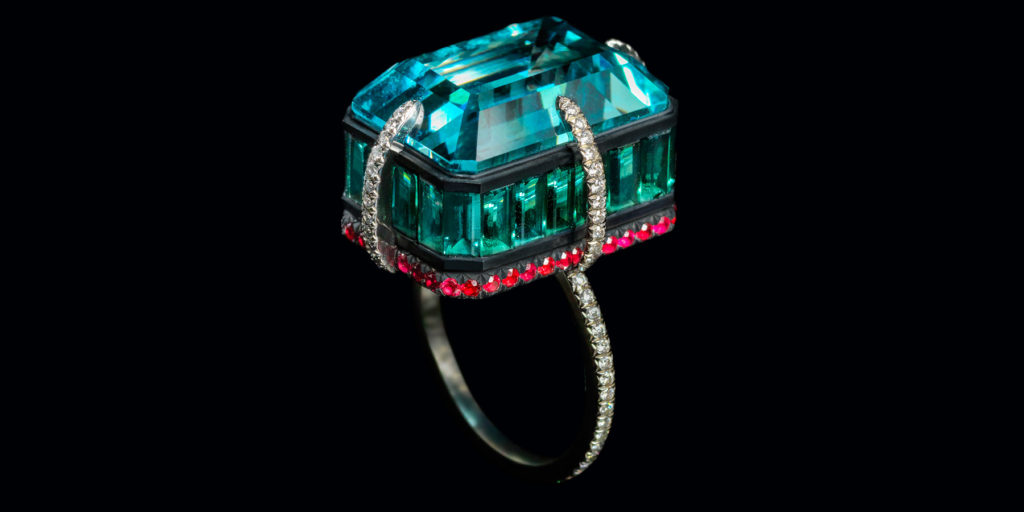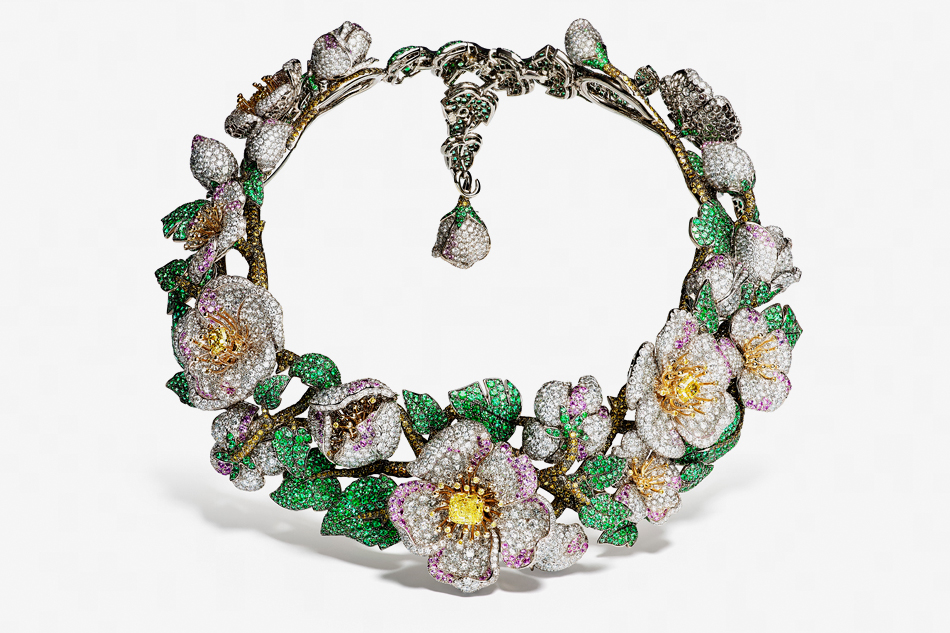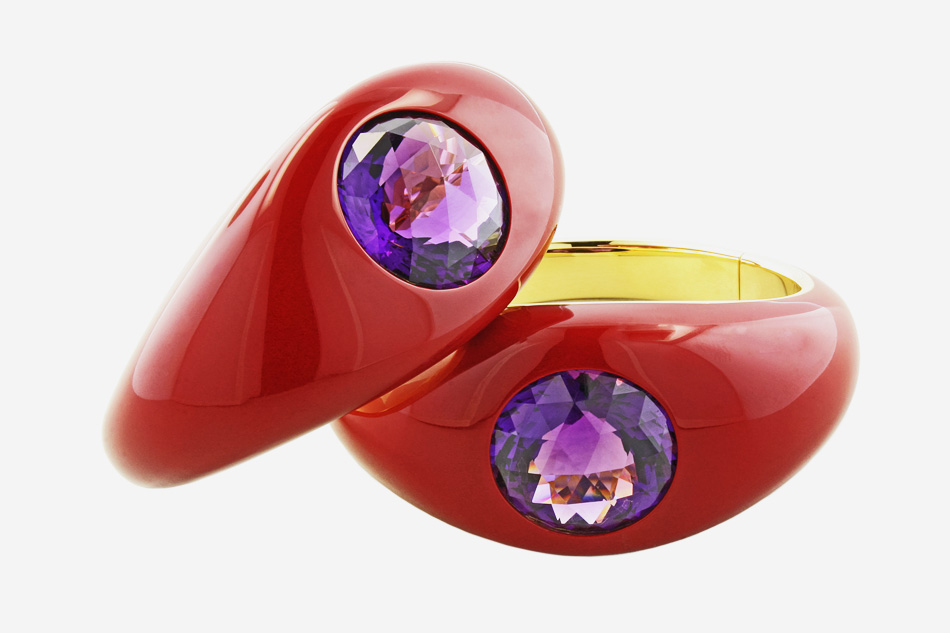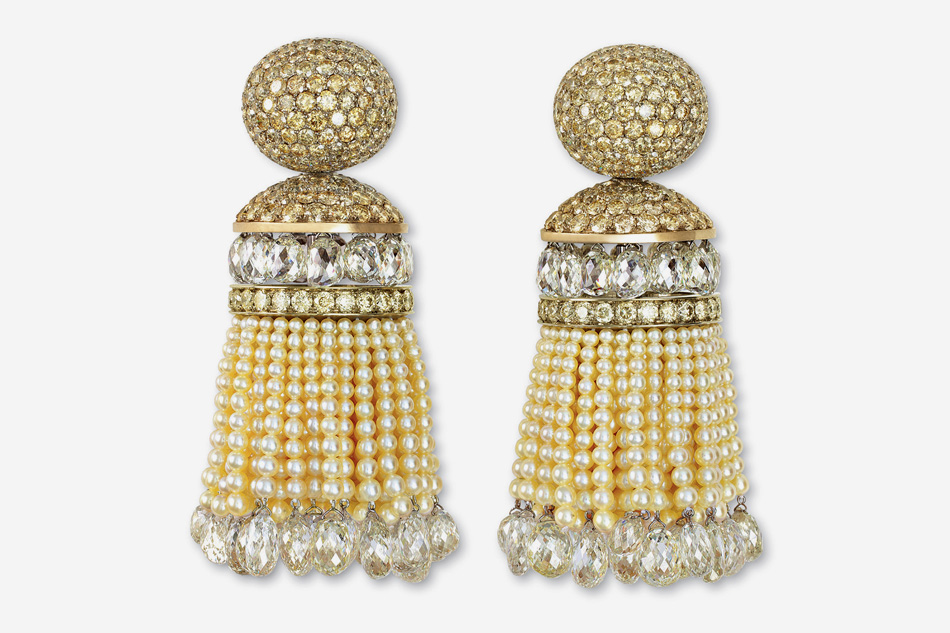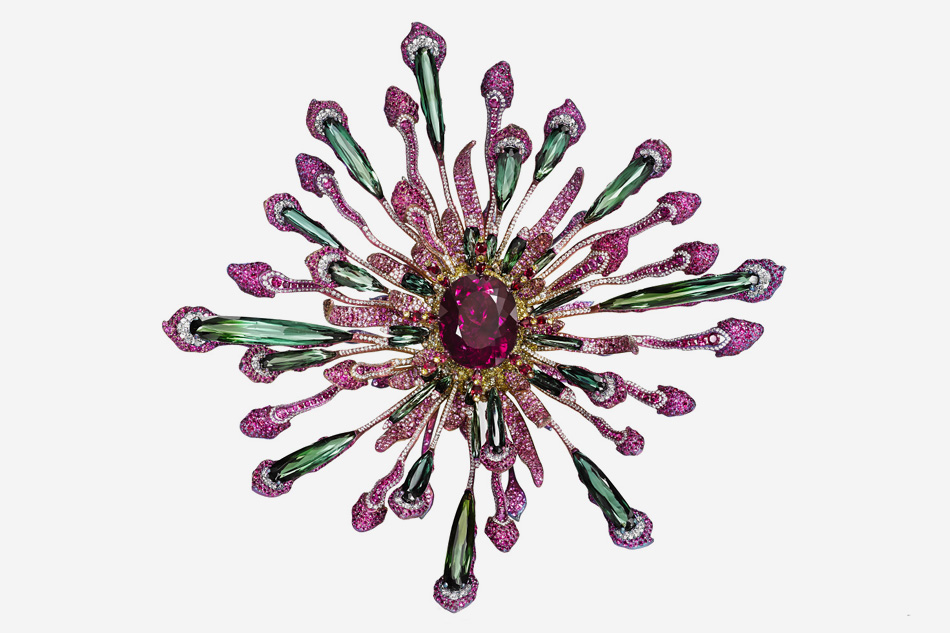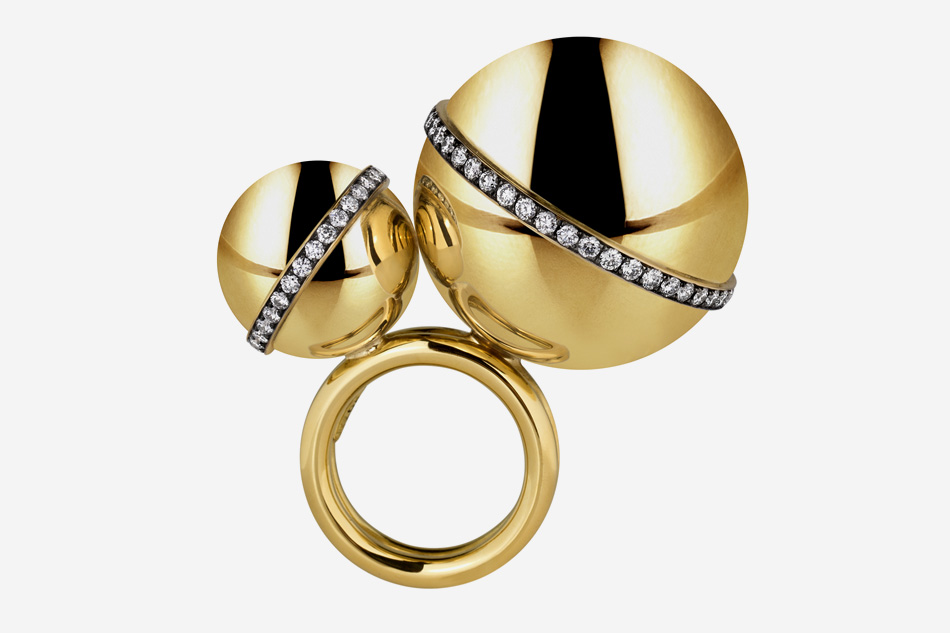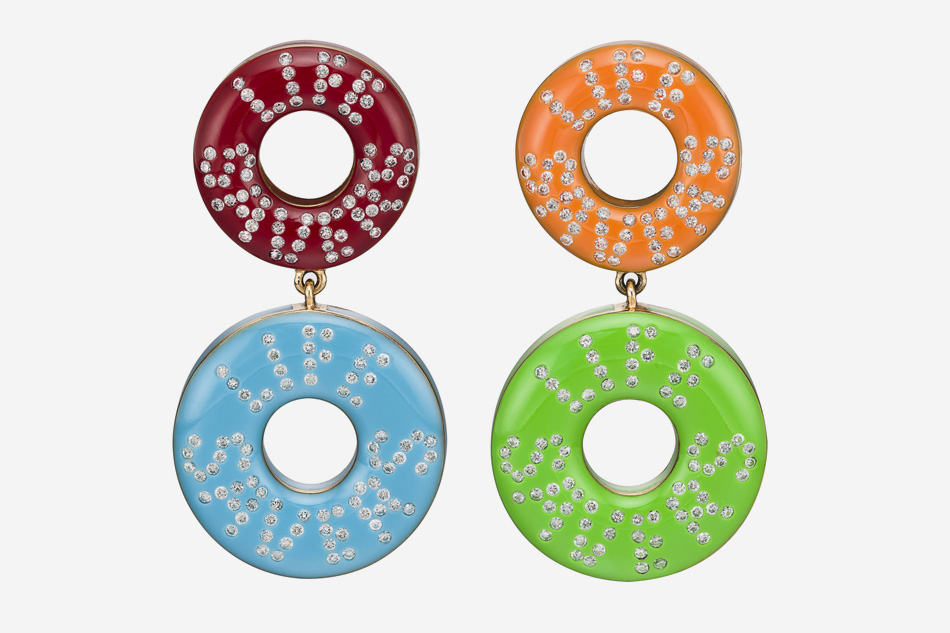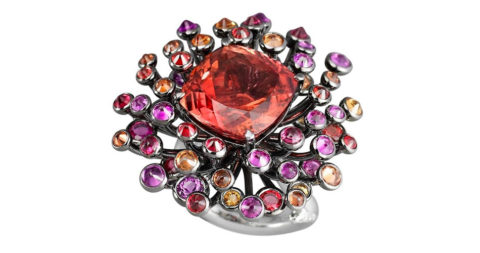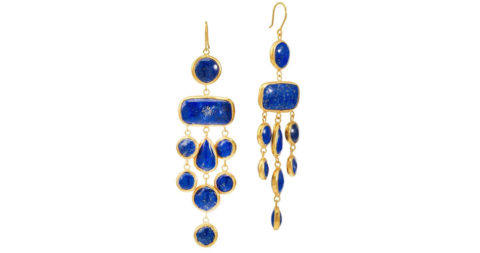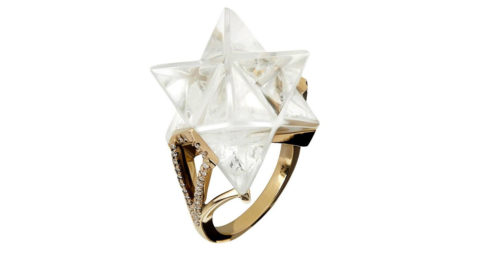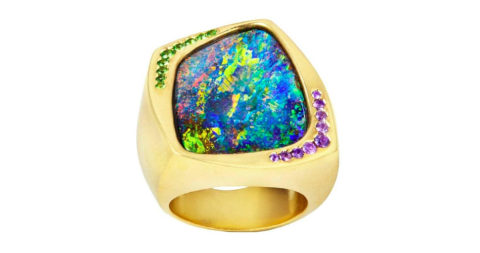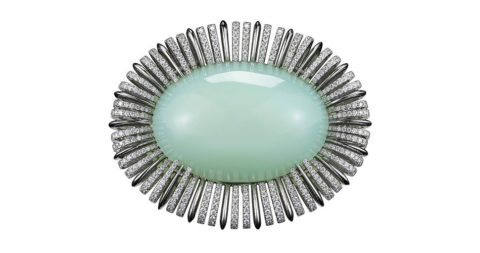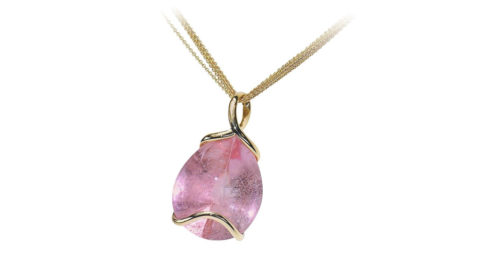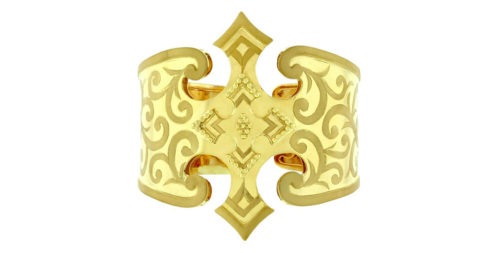
November 7, 2016A new book by Town & Country magazine’s recently appointed editor in chief, Stellene Volandes, celebrates the work of 17 top jewelry designers working today (portrait courtesy Town & Country). Top: Lauren Adriana’s Jewel Box ring of aquamarine, tourmaline, spinel and diamonds. Unless otherwise noted, all photos © Jeweler: Masters, Mavericks, and Visionaries of Modern Design by Stellene Volandes, Rizzoli New York, 2016
Many a woman would not dare leave the house without full makeup, or at least a swipe of lipstick. Stellene Volandes does not step out without jewelry. “I really believe jewelry is like a great jacket or a beautiful pair of shoes — it is meant to be worn,” says Volandes, the editor in chief of Town & Country. “Jewelry in a locked drawer does nobody any good.”
But to Volandes, fine jewelry is more than fashion. In her new book, Jeweler: Masters, Mavericks, and Visionaries of Modern Design (Rizzoli), she makes the case that it should be treated as art. “Jewelry for the larger population means either pretty and shiny things or it is so intimidating that people keep a certain distance from it,” she says. “It’s important for me that people realize that they can appreciate it even if they can’t buy it, the same way you go to a show at a gallery and love what’s on the wall knowing that you do not have ten million dollars. There are ways you can appreciate jewelry even if you cannot consume it.”
By poring over her book, for instance. With text illuminating their inspirations, craftsmanship and artistry, Volandes introduces 17 contemporary jewelers pushing the limits of the field. Each is what she calls a game changer. “Distinctive design is what really defines the people in this book,” she says. “When you see a piece, you immediately recognize it as theirs. There’s that very famous Suzanne Belperron quote, ‘My style is my signature.’ She never signed any of her pieces, but her style was so strong that she felt anybody would be able to recognize it as hers. When I was looking at the people in the book, all their styles are their signatures.”
Most of the jewelers Volandes features are known primarily to connoisseurs, and their pieces tend to be one-offs. While some offer fresh takes on traditional, highly valuable gemstones and metals, others elevate humble materials. “They’ve opened my eyes to see that a piece of wood can be transformed into a precious piece of jewelry, that aluminum looks great with diamonds,” says Volandes. To illustrate that idea, she points to Hemmerle, a fourth-generation Munich jeweler known for juxtaposing diamonds with metals not usually associated with high jewelry — iron, copper and brass, for example — and with found objects like acorns and pebbles. “The objects that they incorporate into their one-of-a-kind, beautiful jewelry — you can’t look at a Hemmerle piece and not have your mind expand as to what jewelry can be. It’s all forward-looking and yet all historic at the same time. A lot of jewelry is like that.”

“If you look at a Bakelite bracelet studded with gemstones, you know that’s Mark Davis — or someone copying him,” Volandes notes of the Brooklyn-based jeweler behind the citrine-, garnet- and moonstone-studded bangles seen here.
Volandes’s appreciation of jewelry was ingrained at a young age, as both of her parents recognized its special romance. “For Christmas and birthdays, it was always a jewelry gift,” she says. “We had a strategy: I would go with my dad to help pick out my mom’s present. I was definitely schooled by my mother in what would be appreciated,” she adds. “It began to be linked in my mind to great memories, to momentous occasions.”
She studied the jewelry in a range of places, from the shops of independent designers near her childhood home in Bay Ridge, Brooklyn, to storied houses like Cartier and Tiffany in Manhattan, to Ilias Lalaounis in Athens, where her Greek-American family traveled often. Her first exposure to the work of the late Jean Schlumberger was at Tiffany, with her father. “I’m sure I had no idea how to pronounce it, but that aesthetic seeped in,” she says.
Those shopping jaunts gradually led to a deeper appreciation of jewelry and its role as artifact. Volandes recalls a particular stop at Fortunoff — a onetime Fifth Avenue retailer with a well-stocked vintage counter — when she tried on an Art Nouveau pearl choker with a large enamel plaque, and the saleswoman who often helped her family explained the significance and signatures of the turn-of-the-century style of decorative art.
“I must have been in high school,” she says. “but I still remember how delicate the work was. I began to see how jewelry fit into a certain period, not just in your life but in history. That is what started to hook me on it.
“Yes, it was beautiful,” she continues, but what sparked her imagination was “when people explained to me that there was a pharaoh on a Cartier bracelet because King Tut’s tomb was found a few years before, or when you see amethyst and citrine in twentieth-century jewelry and realize that, because of World War Two, jewelers had to go down to South America and use the stones they found in the mines there. That’s when you see jewelry fitting into something bigger than just the ring you wear on your finger.”
“Jewelry is like a great jacket or a beautiful pair of shoes — it is meant to be worn,” says Volandes. “Jewelry in a locked drawer does nobody any good.”

Pieces created by Paris-based Lydia Courteille — like these Rainbow Warrior earrings of sapphires, turquoise, amethyst and tsavorites — “are marked by a boldness of imagination,” writes Volandes.
Adding to her fascination with jewelry is the fact that she sees it as a “natural wonder.”
“It’s built on a foundation of craft and tradition, but jewelers always have to be innovative because they are so dependent on natural resources,” Volandes says. “What is the earth giving them this year, and what can they do with it?”
Volandes studied English literature at Vassar, then earned her masters in English and comparative literature at Columbia. Following graduate school, she worked at Vogue and, after a stint teaching at New York’s LaGuardia High School of Music & Art and Performing Arts, she landed at Departures magazine as the style editor. About 20 years ago, the editor in chief there, Richard David Story, handed her the jewelry beat. She thinks he suspected that its historical narrative would appeal to her. “I guess he saw that I always wore a lot of jewelry, too,” she says with a laugh.
From that point, her professional interest hewed seamlessly to her private one. By the time she began the book, which takes a global view of jewelry design, she was the executive style director of Town & Country. And not only was she familiar with all of the jewelers on her list, but she owned pieces by many of them.
She discovered Elena Votsi’s sculptural yellow-gold jewelry, for instance, on holiday in Athens. “I was walking in the Kolonaki area, which is like the Upper East Side shopping district, and there were these amber beads in her window, and I walked in,” Volandes says. “She was there, and we started talking. It was unlike any other Greek jewelry I’d ever seen. She took the idea of Greek gold and stripped it bare.”
For newcomers to the field, Volandes suggests buying designers’ signature looks, whether it’s Suzanne Syz’s diamond-logoed Life Savers earrings in Pop colors or Lydia Courteille’s whimsical rings and brooches shaped like animal heads wearing tiaras. “If you look at a Bakelite bracelet studded with gemstones, you know that’s Mark Davis — or someone copying him,” she says. “You always want the original. Find out who really does this the best, who started it, and go to that source.”
Volandes herself goes for statement pieces. “People sometimes think of statement jewelry as big and bold and crazy,” she says. “But really you can just think of it as something that is not like everything else, that it is very distinctly the work of this designer. That is the statement.”

As is true of all the designers included in the book, Judy Geib’s “style is her signature” — a phrase made famous by celebrated early- and mid-20th-century jeweler Suzanne Belperron, who never signed her work. For this piece, the Amazing Muzo Maze necklace, Geib combined Colombian emeralds, 18-karat gold and 22-karat silver.
Volandes wears certain pieces nearly every day, including a tricolor-gold “rolling bracelet” by Sidney Garber and a small cross charm bracelet, which she found second-hand in Greece in the summer of 2015. “It reminded me of the Cartier Duchess of Windsor cross bracelet, albeit a thrift store version of it,” she says. This year, she’s also been wearing a bracelet with a shield talisman for protection. “The daughters of Ilias Lalaounis, who is one of the wonderful Greek jewelers, gave me this as a good luck charm for 2016, which is shaping up to be a good year for me.” Indeed: She was promoted to her current role at the Hearst-owned magazine in March.
But Volandes wears a lot of jewelry beyond these go-to pieces, and she has fun mixing in eclectic jewels. “With my clothing, I sort of have a uniform; my jewelry is what changes,” she says. Today, she’s sporting a yellow-gold Marina B ring and Nina Runsdorf blingy opal earrings. “They’re big earrings, and some people might not wear them during the day, but I think, go ahead,” Volandes says. “They’re not heavy. My ears, also — I have become immune. If I’m wearing a stud, it’s because I’m wearing so many necklaces. I do like a big earring. I have long hair.”
Volandes, who is a friend of Runsdorf’s, admits that being acquainted with the creators affects how she feels wearing their creations. “You start to see how much of a jeweler’s personality and spirit and emotion go into every piece,” she says. “So when you wear something they’ve made, there’s a sense of their spirit with you.”
Volandes points out that, although our culture tends to consider jewels pure adornment, in some societies they are amulets. “There are pieces where, if I think I’m going to have a bad day, I put them on,” she says with a shrug. “I do.”
Volandes knows the images in Jeweler are mouthwatering. Her fervent wish, however, is that people won’t just drool over the pictures but also read the text, which engagingly captures each designer’s story. “My mission always with jewelry is for people to see it beyond a bright, shiny object,” she says. “If anyone dismisses the importance of jewelry, I advise them to go to the Greek and Roman galleries or the Egyptian galleries at the Met, because through wars, famines, floods, the jewelry is still there. You can walk through those halls, and you see rings and earrings and diadems, and they are perfect.”
She recalls reading a news story last year about archaeologists discovering a Bronze Age warrior’s tomb in what is now Greece, dating back some 3,500 years. “What remained?” Volandes asks. “His collection of gold rings.”
Or support your local bookstore.
Stellene Volandes’s Quick Picks on 1stdibs
